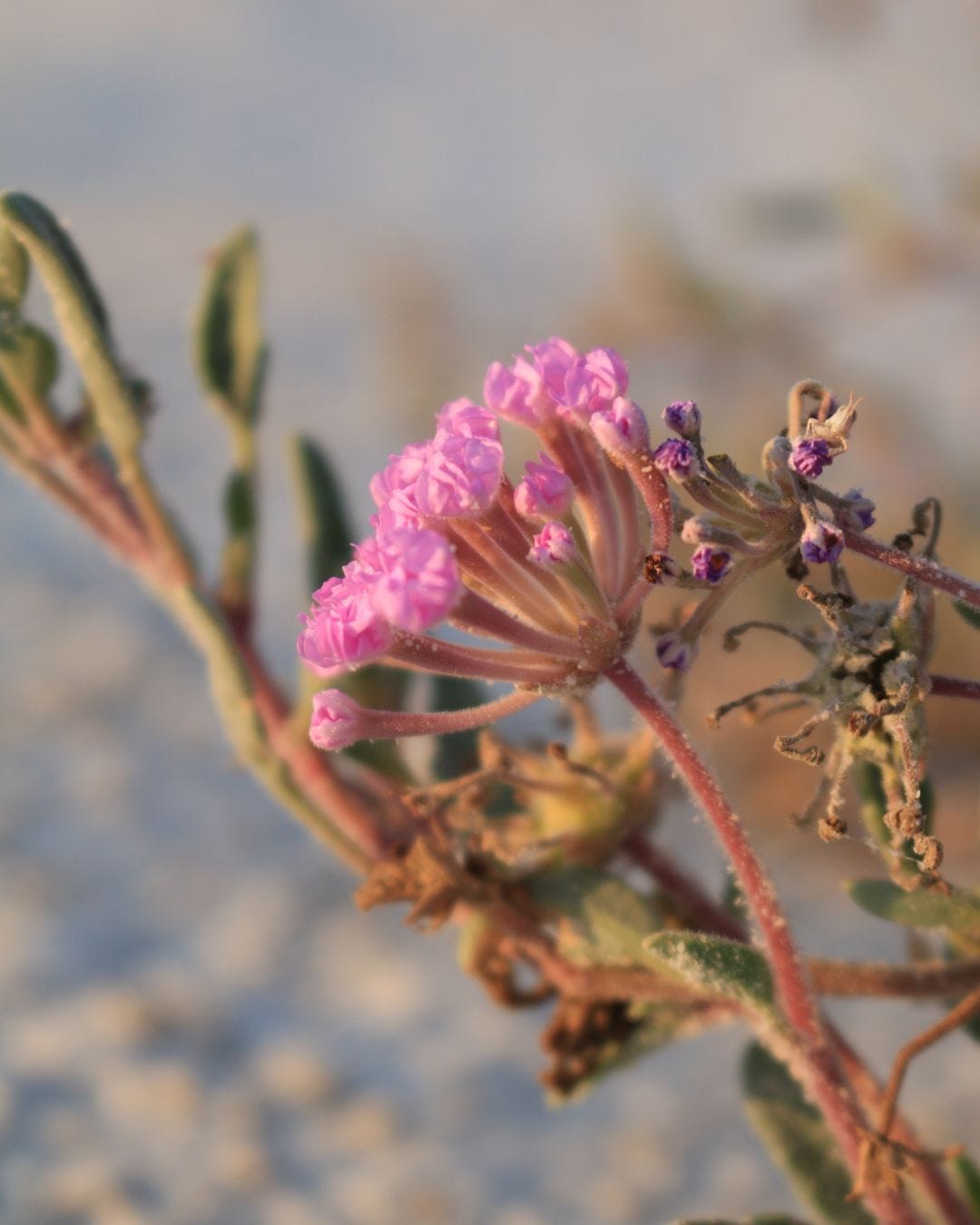Native Plants, and Nature, Digest 7/1-3
Edible plants, Purple Sand Verbena, Q3 LNF SOPA, BLM cleanup, a video about the monsoon, forest updates, and the upcoming Conservation Seedling Program.
(6/21) Edible Plants
“The 39 Top-Tier Edible Plants You Can Forage in New Mexico in 2025,“ by John Clark - Experienced Forager. Updated June 21, 2025.
Article link:
https://rockchasing.com/edible-plants-in-new-mexico/
Spring
• Shepherd’s Purse, Capsella bursa-pastoris
• Dandelion, Taraxacum officinale
• Curly Dock, Rumex crispus
• Plantain, Plantago major
• Sow Thistle, Sonchus oleraceus
• Wood Sorrel, Oxalis stricta
• Lamb’s Quarters, Chenopodium album
• Nodding Onion, Allium cernuum
• American Licorice, Glycyrrhiza lepidota
• Prairie Onion, Allium textile
• Golden Currant, Ribes aureum
• Wild Bergamot, Monarda fistulosa
• Fireweed, Chamerion angustifolium
Summer
• Desert Onion, Allium macropetalum
• Lamb’s Quarters, Chenopodium album
• Cholla Cactus, Cylindropuntia spp.
• Narrowleaf Yucca, Yucca angustissima
• Amaranth, Amaranthus spp.
• Purslane, Portulaca oleracea
• Mesquite, Prosopis glandulosa
• Sunflower, Helianthus annuus
• Wolfberry, Lycium pallidum
• Rocky Mountain Bee Plant, Cleome serrulata
• Canyon Grape, Vitis arizonica
• Netleaf Hackberry, Celtis reticulata
• Skunkbush Sumac, Rhus trilobata
• New Mexico Groundcherry, Physalis hederifolia
• Desert Hackberry, Celtis ehrenbergiana
• Colorado Pinyon, Pinus edulis
Autumn
• Canyon Grape, Vitis arizonica
• Mesquite, Prosopis glandulosa
• Fireweed, Chamerion angustifolium
• Curly Dock, Rumex crispus
• Western Gooseberry, Ribes inerme
• Golden Currant, Ribes aureum
• Wolfberry, Lycium pallidum
• Wild Rye, Elymus spp.
• Skunkbush Sumac, Rhus trilobata
• Netleaf Hackberry, Celtis reticulata
• Saltbush, Atriplex canescens
• Woods’ Rose, Rosa woodsii
• Colorado Pinyon, Pinus edulis
• Nuttall’s Saltbush, Atriplex nuttallii
• Little Walnut, Juglans microcarpa
Winter
• Cholla Cactus, Cylindropuntia spp.
• Indian Ricegrass, Achnatherum hymenoides
• Shepherd’s Purse, Capsella bursa-pastoris
• Saltbush, Atriplex canescens
• Nuttall’s Saltbush, Atriplex nuttallii
• Desert Hackberry, Celtis ehrenbergiana
• Tulip Prickly Pear Cactus, Opuntia phaeacantha
• Wood Sorrel, Oxalis stricta
• Sow Thistle, Sonchus oleraceus
(6/29) A Beautiful iNaturalist Observation
By Cobal.
House Finch, Haemorhous mexicanus. Source.
A couple of finches are atop some yucca seed pods, out in the dunes at White Sands National Park.
(6/30) Bureau of Land Management Cleanup
“Force Account Crews recently completed a three-day clean-up of a decommissioned gravel pit in Otero County. Over 86,000 pounds of liquor bottles, spent shell casings, couches, chairs, and other trash were removed and disposed of at the Otero County Sanitary Landfill.” (Source, and more pictures)
(6/30) Video about the monsoon
“6/30/2025 (Part 1) Fresnal Canyon flood outside La Luz, NM,” by John Bruse.
Video link:
https://www.youtube.com/watch?v=QdwgQN1x2KQ
Lots of rain came down Fresnal Creek.
(Q3 July-Sept) Forest Service Schedule of Proposed Actions (SOPA) for the Lincoln National Forest
Link:
https://www.fs.usda.gov/sopa/forest-level.php?110308
Nationwide:
Locatable Mining Rule
Is on hold.
Forestwide:
Lincoln National Forest Plan Revision EIS
Next year sometime.
Integrated Non-Native Invasive Plant Management EIS
Federal Register in August, decision in October, implementation in November.
Districtwide:
Cloudcroft Hazardous Fuels Reduction and Forest Restoration Project CE
Next year sometime.
South Sacramento Restoration Project
Implemented back in March, and will take the next decade.
(NEW) South Fork and Blue 2 Post-Fire Hazard Tree Mitigation Project CE
Scoping has started, decision in August, implementation in September.
The “purpose and need” section lists 4 reasons, and is multiple pages long.
(7/2) Purple Sand Verbena
By White Sands National Park. Photos by NPS Photo.
“This wildflower Wednesday we are looking at a Ranger favorite: Purple Sand Verbena.🌸
Of all of our wildflowers sand verbena is the flower we see most often. Shortly rising from the interdunal areas this flower sports perennial blooms in shades of pale pink and purple making their first appearance starting in late April and leaving in May. Sparkling in early morning and evening light the stems and leaves of this small but mighty bloom appear a twinkling silver. Gypsum sand sticks to the hairy leaves of this flower giving it its silver appearance.
White Sands National Park is home to several wildflowers, and they are a cheery pop of color against the sea of white sand dunes. Their adorable stature and petite petals may encourage you to pick them, but please avoid their plucking pleas. We like our flowers to remain on their stems, in the ground, so that future visitors and future generations can enjoy their ephemeral grandeur.
If you would like to share the beauty of these flowers with others, please consider taking a picture.
This place, and all that live within it, are your shared inheritance. Please give future generations the opportunity to see this place as you have; leave it better than you found it, leave no trace. (Source)
To learn more about wildflowers in the park please visit the following link:
https://www.nps.gov/whsa/learn/nature/wildflowers.htm”
Forest Updates
Lincoln National Forest:
• (7/3) Fire danger rating lowered to "moderate" and all fire restrictions lifted
• (7/5-7) Prescribed burns in Perk Canyon, south of Sacramento. Usually slash pile burning.
(7/7) Conservation Seedling Program
By the Forestry Division of the New Mexico Energy, Minerals and Natural Resources Department (EMNRD). Seedlings are for sale starting 7/7 (when what’s in stock is made public). To participate in the program you must own at least one acre of land in New Mexico and the seedlings purchased through the program must be used for conservation purposes. Programs are offered both in spring and in fall.
More info:
https://www.emnrd.nm.gov/sfd/seedlings/









